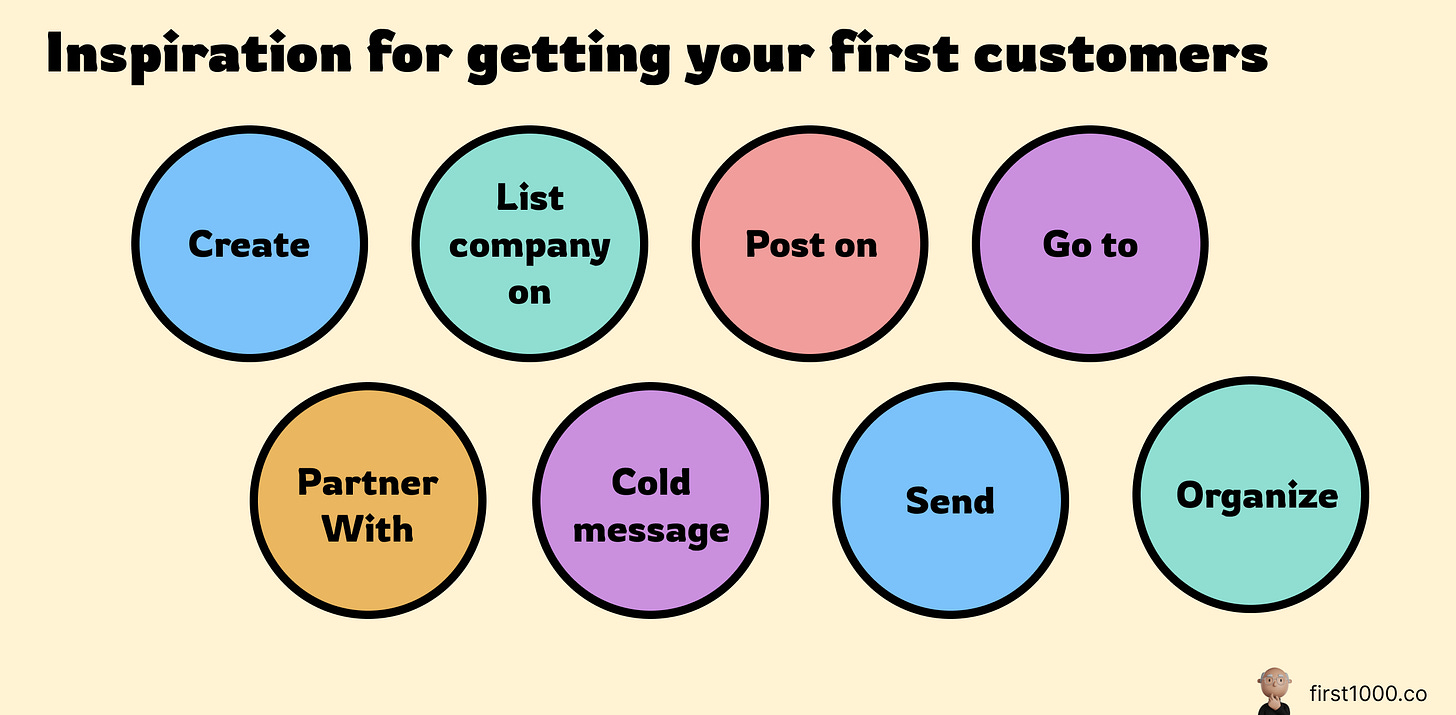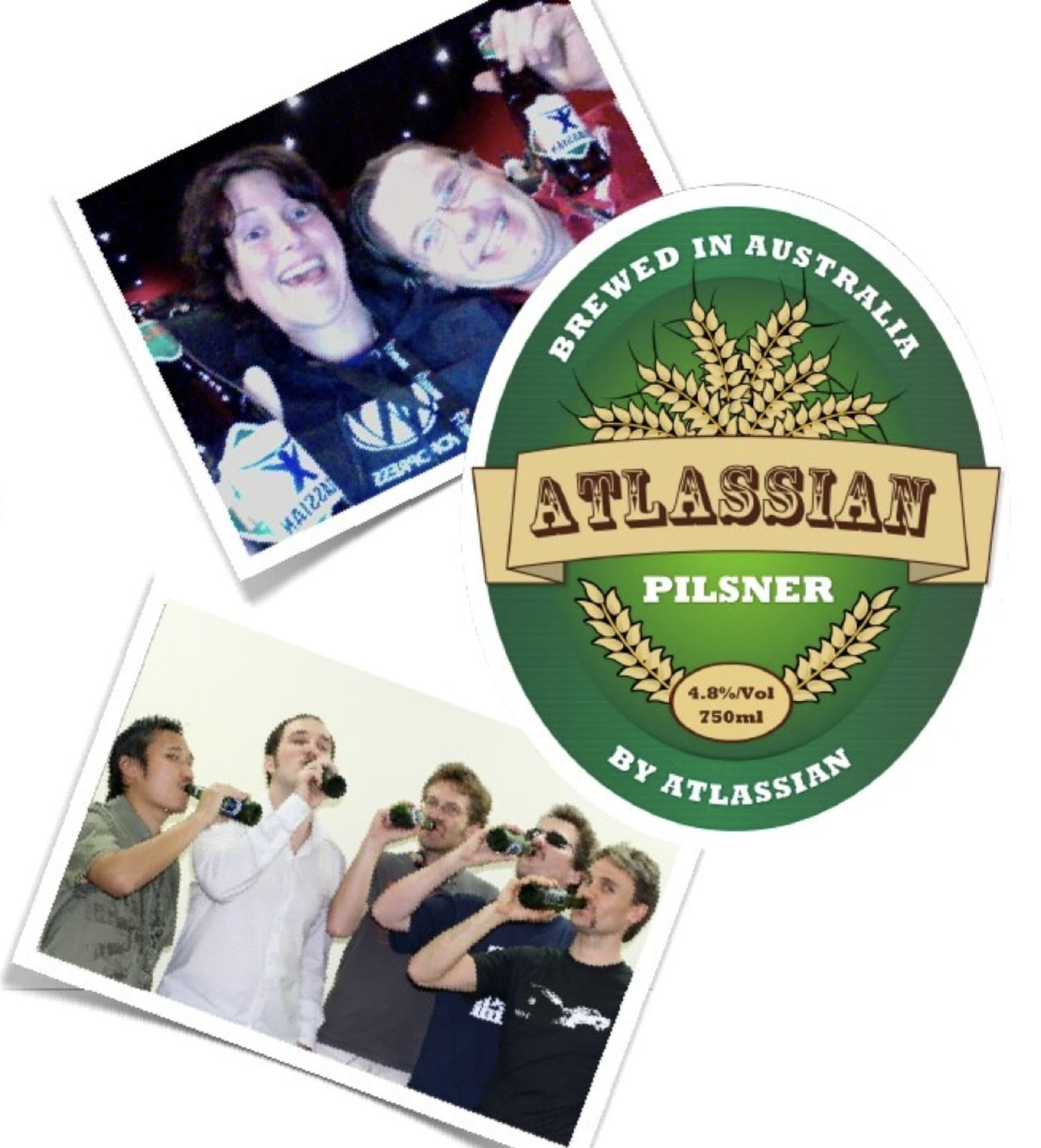53 ideas to get your first customers.
Get inspired by how companies (massive & tiny) got their very first users.
Hello Frens 👋,
Welcome back to this week's issue of First 1000. A few weeks ago, I asked you about how to improve First 1000 (and thank you to everyone that participated in the survey). Many pointed out the idea of having more actionable pieces on getting your first 1000 customers. I intend to do so brings with today's topic: 53 ideas to get your first customers.
Ideally, this issue would serve as an inspiration to find novel ways to attract your first 10, 100, or even 1000 customers. The best-performing growth tactics are often ones that no one (or few) have explored before.
Let’s get started:
Create
A reality TV show
Taking building in public a step further would be creating a reality TV show around building your startup. Gimlet Media's Startup podcast is a great example. Mid-day Snacks did something similar with an IG Live show around building their company live.
An easier tool to sell
Zumper, a rental Marketplace, created a tool to help brokers and landlords to create and upload a listing to all the top 5 rental marketplaces with one click. Two years later, they had over 80% of all live rental listings in NYC & SF.
Irrelevant Cool Stuff
Kapwing, a video editing startup, created a site called Firemap. Firemap is an interactive web app that helps people who evacuated fires see the status of their homes via satellite images. They hosted the app on their domain and got featured in several local newspapers. The company got a nice Google ranking bump as a result.
A Video Pitch
Smart Nonsense does an outstanding job here. Take a page out of the playbook they used to land Ali Abdaal (a famous YouTuber) and Synthesis School as their clients 👇🏽.
Twitter bots
Yarn used Twitter bots to generate over 500,000 impressions for their movie clip search engine. Along the same line, Mixpanel created a script to follow the followers of people writing about the problem they’re addressing. They got 100s of accounts from this tactic.
Swag
Atlassian founders gave out 15 to 20 cases of Atlassian-labelled beer to attendees at the JavaOne conference.
A Tiktok video
Snack, a new dating app, got over 150,000 views by creating this Tiktok video explaining the why behind its product.
Flyers
Uber distributed flyers in front of events, metro stations, and college campuses to attract early adaptors. Also, Groupon distributed flyers with QR codes in front of early vendors on the platform.
An ambassador program
The ambassador program helped Snackpass launch on 10 campuses and took them to over $10m in GMV.
A newsletter
Ladder scaled their remote jobs newsletter to “tens of thousands” of subscribers before launching their product. Their first 1000 users all came from the newsletter.
A lot of Content
A good resource for creating Content is this presentation from Leadpages. The presentation explains how they used content marketing to grow from 0 to 16,000 customers in under a year.
List company on
F6s (for B2B)
Low effort potential high return place to list your company is F6s. Over 4 million founders use F6s to get discounts on software.
Betalist
Betalist is a platform to find early adaptors. Front's first 50 customers came from listing on the forum.
ThingTesting (for DTC)
ThingTesting is glassdoor for DTC brands. Get early adopters (testers) & reviews for your brand by putting your product on the website.
Product Hunt
Product Hunt receives over 100,000 daily website visits. Loom got over 3,000 users from their product hunt launch.
Capiche (for B2B)
Capiche is a community-led platform that offers price transparency and reviews on SaaS products.
Capterra (for B2B)
Over 5 million business software buyers use Capterra to discover & evaluate the software. I found customer.io through Capterra. I’m now in love with customer.io.
Kickstarter
Lambda School, Allbirds & Peloton found their early supporters by running Kickstarter campaigns.
Betabound
If everything else fails, Betabound is a good starting point to find early adopters. They have decent traffic sitting at around 50,000 visitors a month.
Post On
Blind
Blind is an anonymous community for tech professionals. Fractional got 2,000+ leads after posting their idea on the platform.
Competitor's product forums (for B2B)
Zapier found their early adopters by scanning product forums for people requesting the feature they were solving for and leaving a comment directing people to the Zapier website.
Indie Hackers
Prospects, Virtual Mojito, Dorik all got their first 100+ users by building their companies in public on Indie Hackers.
Hackernews
Both Segment & Supabase got 100s of leads from posting (their-then MVPs) on Hackernews and asking the community for feedback.
Reddit
Discord got their first customers from doing a live demo of the product in a gaming subreddit.
Quora
Answering questions on Quora in your domain is a low-effort yet time-consuming way to find early users. Anand from CB insights did a great job leveraging Quora to create awareness for his company (without getting banned).
Discord
“In one month, we launched the website and went to other gaming Discord groups to tell them about this new site we built. We got a ton of traffic just from other Discord groups without spending anything on marketing."
- Brian, Cofounder of E-PalLinkedin
Linkedin is one of the few social media platforms where you can still get a sizeable organic reach. Wonsulting founders build the company on top of actively posting on Linkedin.
Go To
Meetups
DigitalOcean got its first 50 customers by demoing in front of a New York tech meetup. Similarly, Github got its first users from demoing the product at Ruby on Rails meetups.
Tradeshows
Etsy and Nike got their start at Trade shows. Etsy visited one or two trade shows every weekend to recruit sellers. At the same time, Nike relied on the biggest trade show of the year (The National Sporting Goods Association Show) to introduce their athletic footwear.
Client's offices (for b2b)
At 7 am every morning, Bloomberg visited the Merril Lynch office and offered coffee (or tea) to people reading the newspaper. Merrill Lynch became his first enterprise client.
Pitch Competitions
Trello got their first customers by presenting (revealing) the product at Techcrunch Disrupt. They got over 130,000 website visitors over the following 48 hours.
Conferences (for b2b)
Kismet and Twitter got their big breaks by at SXSW (South By South West).
Partner With
Complementors
Speeddate got most of their first 2,000 using the live chat app Meebo and embedded their app on the service.
Alcove got most of their first early listings from owners for their co-living startup by partnering with property management firms."
Newsletters
Udemy's first course was in partnership with Startup Digest, a newsletter that had over 50,000 subscribers.
Communities
Matter, the read-it-later app, found their first users by partnering with communities. These include The Interintellect (run by Anna Gat). Progress Studies (run by Jason Crawford) & The Long Now Foundation
Influencers
Before GamingFrog launched, they spent 3 months creating Content around Fifa and partnered with a Fifa Influencer on Launch day. They snagged 1,000+ users on launch day.
Blogs
Pinterest hosted “Pinterest bloggers” events in the early days. They invited Local bloggers, pampered them, and talked about everything Pinterest.
Reach out to
Potential users on Twitter
Figma found their first users by cold emailing influential designers they found on Twitter.
Previous colleagues (for b2b)
Open Lowcode got their first 100 users from the founder getting his day-job colleagues to try the app.
Reporters
Transferwise cold-emailed Techcrunch to cover their startup, the article landed it over one thousand sign-ups.
Cold leads
Gumroad, Grab, Alibaba and BuyMeACoffee got their first users through cold emails.
Organize
Pop-ups
Honeypot (now Thursday) got their first users by placing whiteboards with quirky messages around the streets of London.
Hackathons (for b2b)
Monzo only gave out demo cards to their Neobank to people who participated in the company-organized hackathons. Hackathons gave them a 24-hour window to pitch potential early users instead of the 7-second someone might spend on their landing page.
Parties
Tinder & Bumble got their start by organizing parties for sororities where attendees needed to download the app to get in.
Community Events
"We started hosting community events for people in our target audience. This helped us because it allowed us to build credibility and our brand instantly, and it gave us an in-person audience for user testing and research."
- Rachna Govani, CEO and Cofounder of Foodstand
✨More things to explore ✨
Create a Course on:
Besides Lambda School I am yet to see a company that started as a course. There may be an untapped opportunity here to develop a long-lasting relationship with early adopters.
Maven: To create cohort-based courses
Thinkific: To create courses with your branding.
Teachable: One Stop Shop to create online courses and coaching services.
Udemy: The original course creation platform
Build a Personal Brand on:
It’s easier to build an audience on new social media platforms than established ones. Some suggestions on emerging apps to building an audience on
Diamond App: A web3 Twitter
Popparazi: A friends-first photo-sharing app
Callin: A social podcasting app
Racket: If Tiktok were an audio company, it would be Racket
Closing Thoughts
This is a guide. Not an instruction manual. Use this issue as a starting point to get the creative juices flowing.
And if you found it helpful, consider sharing it on Slack, Twitter, or Linkedin. I spent goodness knows how many hours researching this piece, so it would be nice if a few more people read it.
Further (highly recommended) reading:
How the biggest consumer apps got their first 1000 customers - Lenny Rachitsky
How today's fastest-growing B2B businesses found their first ten customers - Lenny Rachitsky
Law of shitty Clickthrough - Andrew Chen
Do Things that don't scale - Paul Graham
This is it for today.
See you next week 😉.
Ali Abouelatta







